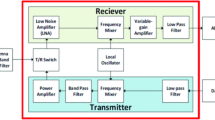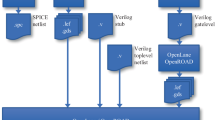Abstract
This paper studies the performance of a memoryless power amplifier (PA) linearization technique based on a probabilistic approach. This technique employs a nonparametric method to derive a predistorter function, which does not need any parametric modeling and explicit parameter estimation. It only needs to calculate a probabilistic cumulative distribution function (CDF) and a quantile function (an inverse function of the CDF). Histogram and order statistic methods are proposed to perform the calculation. A rigorous analytic formula is derived for the inter-modulation product power (IMPP) of the PA output signal when a finite number of samples as well as a finite number of bins are used to calculate the CDF and the quantile function. The analytic results show that, with the probabilistic-based technique, the IMPP approaches zero as the number of samples approaches infinity and the bin width approaches zero.
Computer simulations are utilized to verify the theoretical analysis and to compare the performance of the probabilistic-based linearization technique with those of other memoryless PA linearization techniques, while a prototype experiment is carried out to demonstrate its performance in a practical application. Results show that the technique can accurately determine the predistortion function that effectively compensates for the nonlinearity in the PA, and that it achieves a much better linearization performance compared to other existing methods, especially in the presence of a loop delay in the feedback circuit.














Similar content being viewed by others
Notes
Note that the probabilistic-based technique estimates the PD function from the CDF of the PA output signal. As the CDF calculation is operated in the statistical domain, the probabilistic-based technique allows the use of a very low sampling rate (lower than the Nyquist sampling rate) in the A/D conversion regardless of the signal bandwidth.
Abbreviations
- AIMPP:
-
Asymptotic inter-modulation product power
- AM/AM:
-
Amplitude-to-amplitude
- AM/PM:
-
Amplitude-to-phase
- CDF:
-
Cumulative distribution function
- PDF:
-
Probability density function
- IMPP:
-
Inter-modulation product power
- IMD:
-
Inter-modulation distortion
- PD:
-
Predistorter
- E[⋅]:
-
Mathematical expectation
- \(\operatorname{Var}{[\cdot]}\) :
-
Variance of random variable
- \(\operatorname{Cov}{[\cdot,\cdot]}\) :
-
Covariance of two random variables
- f X (⋅):
-
PDF of PA input signal
- F X (⋅):
-
CDF of PA input signal
- f Y (⋅):
-
PDF of PA output signal
- F Y (⋅):
-
CDF of PA output signal
- N x :
-
Number of PA input signal samples
- N y :
-
Number of PA output signal samples
- \(\mathcal{G}(\cdot)\) :
-
PA transfer function
- \(\mathcal{G}_{A}(\cdot)\) :
-
AM/AM conversion function of PA
- \(\mathcal{G}_{\varPhi}(\cdot)\) :
-
AM/PM conversion function of PA
- \(\mathcal{H}(\cdot)\) :
-
Predistorter function
- \(\mathcal{H}_{A}(\cdot)\) :
-
AM/AM conversion function of predistorter
- \(\mathcal{H}_{\varPhi}(\cdot)\) :
-
AM/PM conversion function of predistorter
References
H. Besbes, T. Le-Ngoc, H. Lin, A fast adaptive polynomial predistorter for power amplifiers, in Proc. IEEE Global Telecomm. Conf. (2001), pp. 659–663
H.H. Boo, S. Chung, J.L. Dawson, Digitally assisted feedforward compensation of Cartesian-feedback power-amplifier systems. IEEE Trans. Circuits Syst. II 58(8), 457–461 (2011)
S.C. Cripps, RF Power Amplifiers for Wireless Communications (Artech House, Boston, 1999)
H.A. David, Order Statistics, 2nd edn. (Wiley, New York, 1981)
H. Dumey, J. Sala, Time delay estimation in digital pre-distortion, in IEEE Int. Conf. Acoust. Speech and Signal Proc., vol. VI (2003), pp. 536–539
L. Erup, F.M. Gardner, R.A. Harris, Interpolation in digital modems. II. Implementation and performance. IEEE Trans. Commun. 41(6), 998–1008 (1993)
M. Faulkner, An automatic phase adjustment scheme for RF and Cartesian feedback linearizers. IEEE Trans. Veh. Technol. 49(5), 956–964 (2000)
F.M. Gardner, Interpolation in digital modems. I. Fundamentals. IEEE Trans. Commun. 41(3), 501–507 (1993)
M. Ghaderi, S. Kumar, D.E. Dodds, Fast adaptive predistortion lineariser using polynomial functions. Electron. Lett. 29(17), 1526–1528 (1993)
D. Huang, X. Huang, H. Leung, Nonlinear compensation of high power amplifier distortion for communication using a histogram-based method. IEEE Trans. Signal Process. 54(11), 4343–4351 (2006)
X. Huang, M. Caron, A novel adaptive type-based baseband predistorter for solid-state power amplifiers, in Proc. of the 20th AIAA Int. Communications Satellite Systems Conf. Exhibit (2002). doi:10.2514/6.2002-1935
X. Huang, M. Caron, Performance of a type-based digital predistorter for solid-state power amplifier linearization, in Proc. IEEE. ISCAS, vol. 2 (2005), pp. 1710–1713
X. Huang, M. Caron, Type-based baseband predistorter function estimation technique for non-linear circuits. US Patent No. 6,885,241 (2005)
V.P.G. Jimenez, Y. Jabrane, A.G. Armada, B. Ait Es Said, High power amplifier pre-distorter based on neural-fuzzy systems for OFDM signals. IEEE Trans. Broadcast. 57(1), 149–158 (2011)
J. Kwon, C. Eun, Digital feedforward compensation scheme for the nonlinear power amplifier with memory, in Proc. 6th Int. Conf. Inf. Technol. Appl. (2009), pp. 169–172
C.H. Lin, H.H. Chen, Y.Y. Wang, J.T. Chen, Dynamically optimum lookup-table spacing for power amplifier predistortion linearization. IEEE Trans. Microw. Theory Tech. 54(5), 2118–2127 (2006)
T. Liu, S. Boumaiza, F.M. Ghannouchi, Deembedding static nonlinearities and accurately identifying and modeling memory effects in wideband RF transmitters. IEEE Trans. Microw. Theory Tech. 53(11), 3578–3587 (2005)
Y.-J. Liu, B. Lu, T. Cao, B.H. Zhou, J. Zhou, Y.N. Liu, On the robustness of look-up table digital predistortion in the presence of loop delay error. IEEE Trans. Circuits Syst. I 59(10), 2432–2442 (2012)
N. Naska, Y. Papananos, Neural-network-based adaptive predistortion method for RF power amplifiers. IEEE Trans. Circuits Syst. II 51(11), 619–623 (2004)
C.D. Presti, F. Carrara, A. Scuderi, P.M. Asbeck, G. Palmisano, A 25 dBm digitally modulated CMOS power amplifier for WCDMA/EDGE/OFDM with adaptive digital predistortion and efficient power control. IEEE J. Solid-State Circuits 44(7), 1883–1896 (2009)
R. Raich, Q. Hua, G.T. Zhou, Orthogonal polynomials for power amplifier modeling and predistorter design. IEEE Trans. Veh. Technol. 53(5), 1468–1479 (2004)
C. Rapp, Effects of HPA-nonlinearity on a 4-DPSK/OFDM-signal for a digital sound broadcasting system, in Proc. of 2nd European Conf. on Satellite Communications (1991), pp. 179–184
K. Rawat, M. Rawat, F.M. Ghannouchi, Compensating I-Q imperfections in hybrid RF/digital predistortion with an adapted lookup table implemented in an FPGA. IEEE Trans. Circuits Sys. II 57(5), 389–393 (2010)
D.W. Scott, Multivariate Density Estimation: Theory, Practice, and Visualization (Wiley, New York, 1992)
B. Shi, L. Sundstrom, Linearization of RF power amplifiers using power feedback, in Proc. 49th Veh. Technol. Conf. (1990), pp. 1520–1524
B.W. Silverman, Density Estimation for Statistics and Data Analysis (Chapman & Hall, London, 1986)
A.S. Tehrani, H. Cao, S. Afsardoost, T. Eriksson, M. Isaksson, C. Fager, A comparative analysis of the complexity/accuracy tradeoff in power amplifier behavioral models. IEEE Trans. Microw. Theory Tech. 58(7), 1510–1520 (2010)
I. Teikari, J. Vankka, K. Halonen, Digitally controlled RF predistortion with digital predictor for feedforward delay compensation, in IEEE S-MTT Int. Microwave Symp. (2005), pp. 2043–2046
A. Zhu, T.J. Brazil, Behavioral modeling of RF power amplifiers based on pruned Volterra series. IEEE Microw. Wirel. Compon. Lett. 14(12), 563–565 (2004)
A. Zozaya, E. Bertran, J. Berenguer-Sau, Adaptive feedforward amplifier linearizer using analog circuitry. Microw. J. 4(7), 102–114 (2001)
A. Zozaya, E. Bertran, Passivity theory applied to the design of power-amplifier linearizers. IEEE Trans. Veh. Technol. 53(4), 1126–1137 (2004)
Acknowledgements
The authors would like to thank the anonymous reviewers for their comments and constructive suggestions, which have been very helpful in improving this paper. The authors would also like to acknowledge Dan Drolet, François Cloutier, and Dhiraj Gangaraju of the Communications Research Centre Canada for their contributions to the prototype development and experiment.
Author information
Authors and Affiliations
Corresponding author
Rights and permissions
About this article
Cite this article
Zhu, Z., Huang, X. & Caron, M. Theoretical and Experimental Studies of a Probabilistic-Based Memoryless PA Linearization Technique. Circuits Syst Signal Process 32, 3031–3057 (2013). https://doi.org/10.1007/s00034-013-9612-5
Received:
Revised:
Published:
Issue Date:
DOI: https://doi.org/10.1007/s00034-013-9612-5




